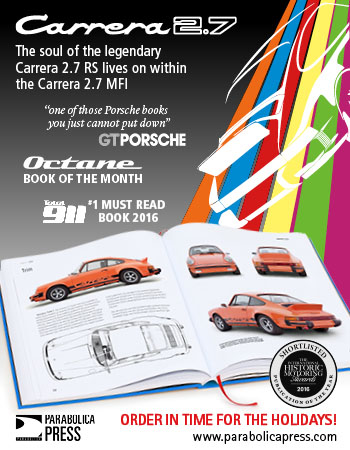Description from the auction house:
- 1 of only 2 built to these specifications
- 1976 Porsche 911 Carrera 2.7-Litre MFI 'Sondermodell' Coupé
- Chassis no. 911 660 9034
- Engine no. 666 8056
- One of only 113 Sondermodells produced
- Desirable last-in-line 2.7-Litre MFI Carrera
- Matching numbers and colours
- Rare sunroof option
- Exceptionally original
Porsche revived the Carrera name for its luxuriously equipped, top-of-the-range 911 in 1973. Designated 'Carrera RS' (RennSport), the newcomer was intended as a limited edition product for Group 4 GT racing, a class that required a minimum of 500 built. However, the resulting demand for this fabulous car proved so great that the production run was progressively extended, eventually ending up at 1,590 units and allowing homologation in Group 3 for standard GT production cars. The majority of cars produced were to 'Lightweight' (competition) specification, the remainder being delivered as the Carrera RS Touring, complete with 911S-type interior trim and fittings.
Based on a lightened 911S platform, the Carrera RS featured revised suspension and wider rear wheels (beneath flared 'arches) for improved handling, while the 2.7-litre, mechanically fuel-injected (MFI), air-cooled six-cylinder engine's 210bhp boosted top speed to around 150mph. Not merely a styling gimmick, the Carrera's trademark 'duck tail' spoiler made a vital contribution to high-speed stability, a virtue of increasing importance as power outputs continued to rise.
Based on the 911 Carrera RS Lightweight announced the previous year, Porsche's RSR GT-category racer collected overall wins in the World Sports Car Championship at Daytona and the Targa Florio in 1973, defeating 3.0-litre prototypes from Ferrari, Matra and Mirage-Ford in the process, an outstanding achievement for a production-based car.
For 1974, Porsche introduced a new body incorporating impact-absorbing bumpers - a US requirement - after which the earlier body became known as the 'long hood' type. In the USA though, the Carrera had to make do with an electronically fuel-injected engine producing 'only' 175bhp (to meet emissions legislation) while elsewhere Porsche's customers enjoyed the legendary 2.7-litre MFI RS-specification 911/83 engine producing 210 horsepower.
The 1976 Sondermodell came with several performance enhancements as standard, including flared rear wheelarches, Bilstein dampers, 18mm rear anti-roll bar, 6" front and 7" rear wheels, and a limited-slip differential. Most importantly, it kept the RS-specification MFI engine. Like all the '76 911 range, the Sondermodell also benefited from Porsche's adoption of the improved Thyssen zinc coating process for the entire bodyshell. Only 113 were built for the 1976 model year.
One of the last 2.7-litre 'MFI' Carreras made, chassis number '9034' left the factory in May 1976 and was delivered new to Germany. The latter was the only market to receive these last-of-the-line Carrera 2.7 Sondermodells, which were reserved for Porsche's most favoured clients, many of them from the racing community. These cars are considered by many enthusiasts to be the last of the 'real' Carreras. Chassis number '9034' is one of only two cars delivered in Copper Brown with the highly desirable electric sunroof option, while other items of special equipment included a rear window wiper and tinted glass.
The Porsche came to Belgium in January 1978 and has extensive Belgian history. In 1992 it was registered by a lady owner, Mrs Melkebeek from Aalst, and there is an old Contrôle Technique in her name dating from 1992 in the file. The car then was put away and hardly ever driven.
In 2012, the Carrera found its way to Holland where it formed part of a Porsche collection. It was then extensively restored with no expense spared, and after completion was featured in Porsche RS Magazine (01/2016 edition). After some 20 years off the road, the Carrera was in exceptionally original condition and an excellent candidate for restoration. In the course of the rebuild, all rubbers were replaced and the car repainted to the highest standard, while the engine and gearbox were totally overhauled. The odometer reading of approximately 80,000 kilometres is believed genuine, a conclusion supported by the condition of the original interior when the car was found. It is most unusual to find one of these ultra-rare 'Sondermodells' - one of the least known models in Porsche history - in such exceptionally original and unmolested condition; indeed, according to Ryan Snodgrass (author of the definite marque history, 'Carrera 2.7', published by Parabolica Press) this is one of the most original 2.7 MFI Sondermodells he has ever seen. The car comes complete with books, tools, and an owner's manual, while accompanying documentation consists of a Porsche Certificate of Authenticity, a copy of the old Belgian registration papers, and a Certificate of Conformity issued by D'Ieteren, Belgium.
Auction house estimate of €175,000 - 275,000 (approx. $200,000 - 310,000).















0 comments
Post a Comment